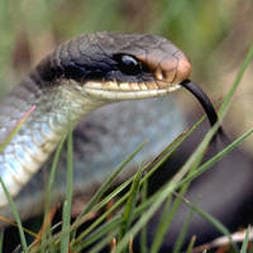Blue RacerColuber constrictor foxii |

Custom Search
|

Their range extends from Canada including eastern regions of Pelee Island to the north and Mexico, Guatemala and, Belize in the south.
This species is also found throughout the US in the eastern regions of the Rocky Mountains in the states of Ohio, Indiana, Michigan, Illinois, Oregon, Wisconsin, Washington, western South Dakota and Iowa. The blue racer snake can be found in open or semi-open habitats, like hedgerows, meadows, savannas or weedy lake edges and marshes and all these habitats are necessary for fulfilling their ecological requirements. These snakes are very intolerant to human activity for this reason they prefer to live in areas with fewer human habitations. Usually, they are among the first snake species to disappear from developing suburban areas. Their habitat can occupy an area extending up to 25 acres, but a large number of them can live in the same area, as the species is not territorial by nature.
As their common name suggests, the blue racer is a very fast snake that can move at speeds of almost 7 Km or 4,3 mph, even so far from the lightning speed of the highly venomous black mamba.
This speed helps them catch prey or avoid being preyed upon. The species lifespan in the wild ranges from 15 to 20 years. They are active during daytime and prefer to spend most of their time on the ground, but are known to forage both on ground and trees. The blue racers are known to hibernate in large groups during the cold winter months. When hunting they hold up their heads up and move very fast through brushes using their keen eyesight. The blue racer will try to escape into the bush and may even climb into low bushes or small trees if threatened. Even though they are non-venomous, they are still very capable of inflicting a painful bite if cornered. We usually catch only a glimpse of them as they disappear quickly through the vegetation. When threatened, they vibrate their tails to make a buzzing sound that works as a warning and for that reason are often mistaken for rattlesnakes. 
Their length ranges between 35 to 60 inches (90 to 152 cm) and it's one of the largest snakes found in Ontario.
The underbelly color is a creamy white, the backside varies from a brilliant blue (hence their common name) to a dull gray and they have light brown to gray dorsum. They have smooth scales, large eyes, and a brownish orange snout. Unlike adult blue racers, hatchlings and juvenile snakes display dorsal blotches that will eventually fade away by their 3rd year. Some of the large birds of prey like the red-tailed hawk, northern harrier, and great horned owl are amongst its predators but they are also preyed on by coyotes, foxes, raccoons, dogs and feral house cats or wild cats. Diet / Feeding The juvenile blue racers eat crickets and other insects such as spiders or worms, adult snakes feed mainly on small rodents, frogs, birds and other smaller snakes such as the ringneck snake. The blue racer is an active forager and despite their scientific name, it isn't really a constrictor. Reproduction
The blue racer breeding season occurs in the spring, from April continuing throughout May. The female will lay anywhere from 5 up to 28 eggs oval eggs around 2.5 cm to 3.9 cm long with a leathery shell, in late June. The hatchlings will have to use their “egg tooth” to cut their way out. The eggs hatch in late summer from mid-August to late September, and the young measure around 8 to 11 inches (20 to 30 cm) in length. The most commonly used nesting habitats are rotting logs but blue racers also deposit their eggs under rocks, sand, tree cavities, leaf litters, decaying organic matter or underground in unoccupied animal burrows. Sometimes blue racers nest communally, and it seems to be a relatively common occurrence, they even nest with other species namely the eastern fox snake. These snakes reach sexual maturity at 2 to 3 years of age.
Conservation / Threats
Human persecution and road mortality, as well as human development, are threatening this vulnerable snake species. The blue racer is considered "Endangered” by the COSEWIC, being listed as endangered in Canada and listed as special concern species in the state of Wisconsin in the US. The last record of the blue racer on mainland Canada was in Ontario in 1983, on Pelee Island, the species is restricted to the eastern parts of the island. The species has been on Ontario's Endangered Species List since 1971, so the habitat deemed critical to the species survival is protected from destruction or significant alteration. The blue racer is yet to be evaluated by the IUCN for their red list. |
Did You Know?
The gaboon viper snake has the longest fangs measuring up to 2 inches (5 cm), and also the highest venom yield of any venomous snake. Scientific classification |
© 2014 Snake Facts About Us | Privacy Policy | Contact





